
oh darling i know how it hurts when your dreams are too far from reality...
953 posts
Networking Tips For Attending An Ivy League For The First Year ?
Networking tips for attending an Ivy League for the first year ?
I didn’t attend a top Ivy League university (congratulations by the way, this is a great acheivement!), But I did attend a top Canadian university which was hard to get into.
My personal tips from my experience are to NOT hesitate to go to people, and focus on making FRIENDSHIPS. If you come at people only wanting to network, they’ll gonna feel “used”, and not appreciate it so much. Focus on learning more about them as people, what they like to do, socialize, have some goddamn fun instead of being stuck up.
Once you know them as friends, they’re so much more valuable as network points compared to acquaintances.
You’ve probably seen that advice elsewhere, but GO TO CLUBS. The people that go there esp at the beginning of a uni year will be more open-minded for socialization and friendships. Apply everywhere. Look around for tennis buddies, join the running club, there’s surely a movie club where you can chill with other folks.
Don’t always couple up with your good mates for teamwork, try new folks too, and as you do the teamwork, (reasonably) ask them questions outside of school. Be careful with this w/men as they might perceive this as flirting or expressing romantic interest.
Go to well known parties (where a lot of your friends will be going, always bring a safety female friend with you), to be a known face. Later it makes it easier to connect with unknown folks (“Hey we did see each other at Anna’s party! I wanted to meet you since you looked like a really nice gal!”).
Never ever ask for a “mentor” blatantly. Just ask the better ppl questions, and favors, and THANK THEM! The mentorship relation is naturally formed, not formally formed. Go to your teachers for asking (researched) questions about stuff you don’t quite get, and be really pleasant, asking them how they’re doing, etc. They’re gonna become more favorable towards you. That’s how I did get a good teacher mentor to help me through my studies and beyond. They’re humans too and appreciate being seen as such, not academic performance machines.
-
 fatass-haver liked this · 1 year ago
fatass-haver liked this · 1 year ago -
 kirinkat liked this · 2 years ago
kirinkat liked this · 2 years ago -
 empressarchives liked this · 2 years ago
empressarchives liked this · 2 years ago -
 sweetberryangel reblogged this · 2 years ago
sweetberryangel reblogged this · 2 years ago -
 dangerouslovx liked this · 2 years ago
dangerouslovx liked this · 2 years ago -
 pizapizzapizzza liked this · 2 years ago
pizapizzapizzza liked this · 2 years ago -
 celinecounty liked this · 3 years ago
celinecounty liked this · 3 years ago -
 memychaos reblogged this · 3 years ago
memychaos reblogged this · 3 years ago -
 ksenias liked this · 3 years ago
ksenias liked this · 3 years ago -
 duskypinki liked this · 3 years ago
duskypinki liked this · 3 years ago -
 distinguishedcloudfishbiscuit liked this · 3 years ago
distinguishedcloudfishbiscuit liked this · 3 years ago -
 rosegoldripper liked this · 3 years ago
rosegoldripper liked this · 3 years ago -
 sjjsjbs reblogged this · 3 years ago
sjjsjbs reblogged this · 3 years ago -
 sjjsjbs liked this · 3 years ago
sjjsjbs liked this · 3 years ago -
 blessedgoddessm liked this · 3 years ago
blessedgoddessm liked this · 3 years ago -
 despondentgirl reblogged this · 3 years ago
despondentgirl reblogged this · 3 years ago -
 honeyslambam liked this · 3 years ago
honeyslambam liked this · 3 years ago -
 shyfestivalrebel liked this · 3 years ago
shyfestivalrebel liked this · 3 years ago -
 lots-of-olives-on-my-pizza liked this · 3 years ago
lots-of-olives-on-my-pizza liked this · 3 years ago -
 golden-shani liked this · 3 years ago
golden-shani liked this · 3 years ago -
 elysianparfume liked this · 3 years ago
elysianparfume liked this · 3 years ago -
 feminine-fancy-favoured liked this · 3 years ago
feminine-fancy-favoured liked this · 3 years ago -
 jeajxb liked this · 3 years ago
jeajxb liked this · 3 years ago -
 linsimin liked this · 3 years ago
linsimin liked this · 3 years ago -
 yazzymin104 liked this · 3 years ago
yazzymin104 liked this · 3 years ago -
 6ixting liked this · 3 years ago
6ixting liked this · 3 years ago -
 jacedv reblogged this · 3 years ago
jacedv reblogged this · 3 years ago -
 jacedv liked this · 3 years ago
jacedv liked this · 3 years ago -
 bimboficacion liked this · 3 years ago
bimboficacion liked this · 3 years ago -
 brownskpisces liked this · 3 years ago
brownskpisces liked this · 3 years ago -
 myworldmatters liked this · 3 years ago
myworldmatters liked this · 3 years ago -
 blackcatmaya liked this · 3 years ago
blackcatmaya liked this · 3 years ago -
 tiffanyspink liked this · 3 years ago
tiffanyspink liked this · 3 years ago -
 nubian-bratzd0ll reblogged this · 3 years ago
nubian-bratzd0ll reblogged this · 3 years ago -
 txririi liked this · 3 years ago
txririi liked this · 3 years ago -
 erik-johnson6 liked this · 3 years ago
erik-johnson6 liked this · 3 years ago
More Posts from Memychaos
A list of winter aesthetics
Holding hands under blankets
Listening to old songs and letting them carry you to an another time
Owning a journal and filling it with your favourite moments of the season so you won't forget about them because they will become moments from your past one day so they are important
Picking up a random book from your dusty shelf and daring to finish it
Covering yourself with tones of clothes from head to toe
Sleepovers with friends
Having lunch dates with friends in their car while the rain is pouring outside
Hydrating and moisturizing
Drawing symbols on the windows covered with humidity
Spending your free time napping or getting cozy under your blankets while watching your favorite movie
Making handmade cards then sending them to your dearest people
Rescuing stray cats and giving them shelter
Romanticizing your life by thinking that everything you do is worth the care and admiration
Reading, reading and reading
Going to art exhibitions of artists you've never heard of
Long walks alone or with your friends and making up back stories for people you see on the street
Waking up early than usual when the world is still asleep
Listening to some playlists made by strangers on the internet
The agreeable warmth of your cocoa cup between your hands
Feeling the delicate coldness of the snowflakes on your skin

early spring bloom vii
ig
Networking And Communication: The Essentials
I have spent the last month going through the Cisco Network Academy learning the essentials of networking and communication technologies. I learn a lot easier when I write things down so here is my best attempt at giving you a thorough guide to networking and communication. Below is everything that I have learned so far - condensed for your ease.
Networks
The internet is a huge network of interconnected servers, hosts, routers, switches, peripherals and IoT gadgets. They are all connected via wired or wireless technologies such as Ethernet, Fibre Optic, Coaxial cable, Bluetooth, NFC, etc.
A LAN is the smallest type of networking and it usually consists of a host computer, a router and perhaps a printer or some other peripherals. These are often found in your home. A WAN is a wider network that can be accessed by many different LANs but is still not accessible to the wider network. You can think of a WAN as many LANS connected together. (Think of a University network).
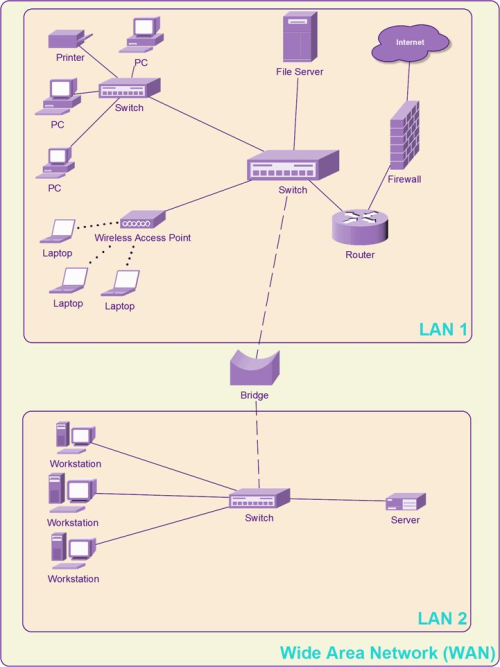
Switches - these are devices that are responsible for the movement of data traffic on a local network (when the data is moving from one local host to another on the same network).
Routers - these devices are responsible for the movement of traffic from one network to another (and this can include destinations across the internet).
Most home ISP routers will also include a default gateway server (which wraps up data packets in the IPV4 packet ready to send over the internet), a DCHP server (which is used to allocate local logical addresses for hosts on a local network) and a switch all at once.
Data Transmission
One of the most fascinating aspects of networking is how the data is transmitted across huge distances in such as a small amount of time. And it’s even more impressive when you learn that the medium over which the data travels is constantly changing throughout its journey. For example, you may send data to a server in Africa and it may travel through fibre-optic, ethernet, co-axial, satellite transmission to get to its destination.
These various mediums of data transmission rely on a variety of different techniques to transmit this information. For example, ethernet and coaxial cabling relies on electronic impulses sent through the wiring to read and send binary data. The same can be said about fire-optic cables but instead they use light beams which also pulse quickly to create binary data.
You can use light at varying frequencies to work together at the same time without interfering with each other. For example, let’s say that we have a fibre optic cable - inside this cable there is one glass tube sending data back and forth to two computers. We could send just one flash of white light every tenth of a second or so and this would transmit data (albeit at a very slow rate) - but we have developed a technique called dense wavelength division multiplexing (DWDM) which splits the light into different frequency bands (for example, one light is blue light, the other red, the other yellow). This way, we can send three streams of data down the same tube which increases the data transmission rate by three times!

Packet Switching and Encapsulation
As previously mentioned, the internet is a network of a variety of different mediums and media which travel great distances and use a huge variety of different technologies. So how can we ensure that data gets to the right place and in one piece? We use protocols.
Protocols are a set of rules (usually set up by a authority like the IEEE) that dictate how data should be communicated across the internet. This way, even if the computer is ten years old it can still communicate with new computers because they understand the same rules of communication. Much like how humans have interpersonal ptorocols such as a hand shake, saying hi, eye contact, saying goodbye etc.
There are a variety of protocols that make the internet work but here is a quick breakdown:
MAC / Ethernet - MAC protocol is used for the data communication between two NIC cards on the same network. For example, if you are sending information from your PC in the bedroom to a PC in your living room it is using the MAC protocol.
IP/ TCP - The IP protocol is designed for data transmission over different networks and is mostly associated with the internet. TCP is a protocol that runs at the same time as the IP protocol - this protocols job is to ensure that data transmission has been received in order and no packets were dropped.
HTTP - HTTP is a protocol that is at the ‘Application’ layer of the protocol stack (something I will show you later). This protocol is designed to provide the client with information such as HTML and media. (basically anything you see, read or hear on a website).
Networking devices rely on a layered service architecture when transmitting data. What this means is that there are a number of layers that are co-existing that are in charge of different aspects of the transmission journey to ensure that it goes smoothly.
Along its journey from your local computer to a destination server your data may encounter various mediums and will abide by different protocols along the way in a process known as ‘encapsulation’. Look at the image below:
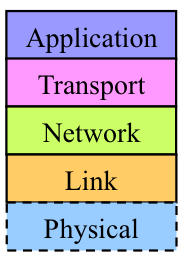
Here we have a ‘protocol stack’ diagram. The physical section of this diagram has dotted lines because although it does feature protocols (such as the ethernet protocol) it is usually hardware and we can ignore that for now. Let’s just assume that physical means hardware such as ethernet cables, NIC cards, ethernet ports etc.
The ‘link’ element of the stack would include the MAC protocol which uses ethernet to send data from one local host to another.
So the computer will create an ethernet packet with a destination MAC address (computer 2) and a source destination address (computer 1) in its header. In the body (or payload) it will hold the actual information that is being shared. This packet is called an ethernet ‘frame’. You can see how the frame would look below:

When we are sending information back and forth to to other computers on the internet this works just great. Usually (due to DCHP servers) the switch will have in its routing table the MAC address of most of the hosts that are directly connected.
But if we wanted to send information to a computer that was on a different network then we would need to move up the layer architecture and use the IP/TCP procotol. So the computer will take the ethernet frame above and send it to the Gateway server (this server is responsible for encapsulation and de-encapsulation).
When the ethernet frame gets to the gateway server the ethernet frame (above) is put into an IP container (imagine russian dolls). The IP frame now uses a IP address of the source computer as its source and the IP address of the destination IP is used as the destination. This IP packet wraps around the ethernet frame and keeps it safe as it travels across the internet.
Now as this router sends the IP packet to the destination it may not be able to do that in one “hop” (jump from one network to the next). So it looks for the next router on its journey and finds its MAC address. It takes its own MAC address and replaces the old source MAC address with its own and replaces the old source destination MAC address with the next router. The IP source and destination stay the same throughout the journey. So you can imagine that data travelling across the internet is basically from router to router and at each meeting they change the old MAC addresses to the news one required for the next hop.
Global and Local IP Addresses
There are two different types of IP address that we work with on a daily basis when using the internet. You may have noticed that the local IP address for your computer is or close to a friends computer at his house? Perhaps it looks like 192.168.0.119 or something similar to this. This is because when we are connected to a LAN network (for example, two laptops connected to your home ISP router) the two computers on this network are automatically assigned a local IP address that is the same for every router across the world. The range that is assigned for most home, small businesses is 192.168. 0.0 — 192.168. 255.255.
The ISP router that you are connected to actually has a public facing IP address that can be seen by other networks and the internet. This is what’s called a global IP address. This is what servers like google.com send data traffic to when you request a search on their website. It is the routers job to then distribute that information via MAC procotol to your computer. This process is called Network Address Translation (NAT) and is used by the router whenever it receives data from an external source.
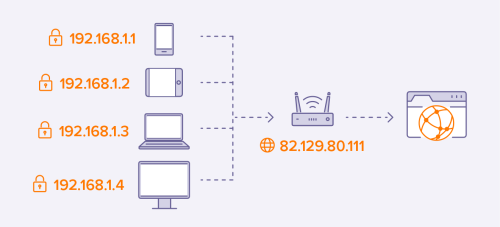
These are some basic networking principles that are important to understand and I hope this has helped develop your understanding.
Doses of Glamour ⚜️
How to make your LinkedIn profile stand out and how to connect with others.
I accidentally deleted this anonymous question. Here is my response, hopefully you see it anon. ✨
Your profile photo:
You want a professional photo that best show cases your personality. It’s how people are introduced to you and it governs their impressions from the start. The photo should be well lit with little to no distractions in the background.
It goes without saying but your outfit should be beautiful but work appropriate. Wear colours that best compliment your skin tone and make you look radiant. Avoid wearing distracting patterns, solid colors work best.
Keep your makeup simple and elegant.
Lastly ensure in your settings that your profile photo is visible to all LinkedIn members, you want recruiters to be able see your profile photo.


Headline: A great headline should
Show recruiters who you are
Show what you can do for them
Use role specific keywords so that you appear in search suggestions
Examples of good headlines:



LinkedIn summary and about section:
Your LinkedIn profile is your resume and it should be formatted as such, make your LinkedIn summary keyword-rich.
Keep in mind recruiters search for a combination of job titles, skills, and other keywords to find the right candidates.
Learn and understand your audience to identify what they are looking for.
Review job descriptions that interest you and take note of recurring hard skills and keywords that you think recruiters would want to look for. If applicable to you and your career goals, add these words to your LinkedIn summary and profile.
Your LinkedIn summary is the perfect place to add context to your career trajectory, show off your accomplishments (add specific data and awards), and dig into what makes you great at your job.
An example of a students LinkedIn summary:
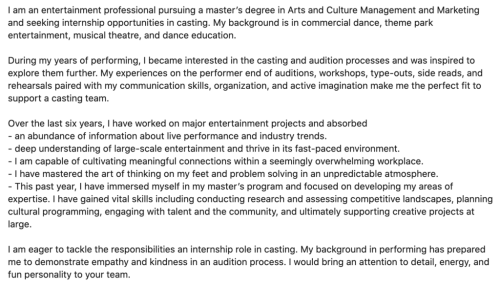
An example of a job seekers LinkedIn summary:
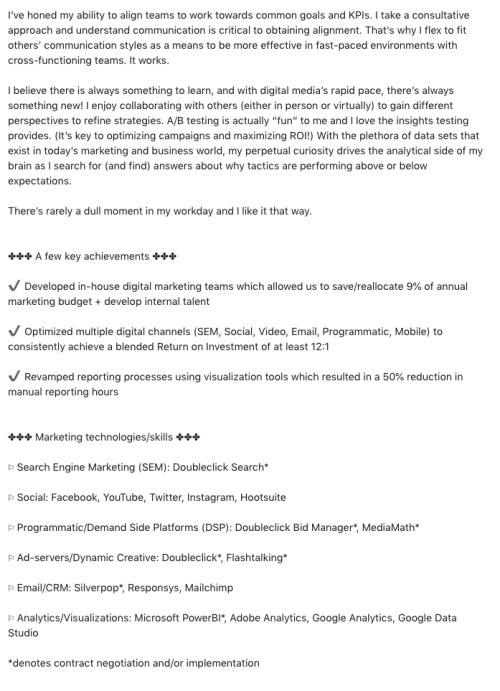
An example of a career change LinkedIn summary:

Job Experience:
Focus on showing your impact in the role rather than just highlighting your responsibilities, use your bullet points to share the problems you were presented with, the actions you took, and the positive results it brought the business. Exemplify this by making use of metrics as well.
Examples of impact statements:
Coordinated with the marketing team to form a 10-person group for a new product launch that resulted in $50,000 in company revenue and greater synergy between both departments.
Surpassed annual sales goals by over 35% for four consecutive years using active listening and communication skills to better understand customer needs.
Analyzed market trends to launch five new products within a year that resulted in a 30% profit increase for the company, up from 10% from the year prior.
Education, License & Certifications:
Include information on all your formal educational training, it’s especially beneficial when aside from formal educational training you have additional certifications on hard skills.
Key Skills:
I already mentioned that recruiters input specific skills or keywords into complex queries to find candidates in LinkedIn search.
So the skills you list throughout your profile should match the frequency and exact wording found in the descriptions of jobs you’re interested in or have applied for.
Additional Note on optimizing your LinkedIn profile. Change your settings to let recruiters know you’re open for work.
Who to connect with on LinkedIn:
Professionals in your industry.
Professionals in your desired role.
Professionals you’ve engaged with at industry and networking events.
Recruiters and hiring managers in your industry, especially if their profiles mention that they are hiring.
Message templates to use to connect with others on LinkedIn:
Template for career guidance and potential mentorship:
Dear (Name)
I’m a (state occupation or simply mention that you’re a student and the college you attend) interested in working in (desired role) For the last year, I’ve been following your work for (company), and it’s really inspired me.
I particularly loved your (compliment a recent article or achievement of theirs and mention what stood out to you). If you ever have 20 or so minutes, I’d love to hear more about how you started working in the field and what skills you believe are most relevant to the profession.
Regards
Template for someone you met at a networking event:
Dear (Name)
It was great speaking to you at the (name of event ) ( Highlight something significant they mentioned in your conversation and how insightful you thought it was.) I’d definitely like to stay in touch.
Regards
I’ve given you the ultimate LinkedIn guide, now go get your bag!

Signed
Doses of Glamour ⚜️
🔑No. 1 advice I have for you today: please don’t isolate yourself.
It’s okay to mind your own business and stay in your own lane. But make sure to keep yourself informed about events happening around you. Always have allies. Isolation is dangerous. Running away isn’t your advantage. Not having a clique or someone you can rely on around you at your workplace, school or university is bad. Humans are social animals. We need to socialize and talk with others. Stay on your ground and have standards, but make sure to be polite to your colleagues and everyone else. Make yourself seem desirable and visible. There’s a difference between being independent and alone. Nobody likes a loner. You can have your time off at any time of the day you’re free, but maintain relationships with others. If you don’t have any allies/friends, make sure to find and make them. I see too many posts about self-care and while it’s 100% essential for success, it is also important to keep yourself informed, seen, and noticed. And while your skills are super important, if you’re not coming from a high-class background, you got to network. You got to make yourself stand out and you can do it much more easily if somebody who’s above you notices you. If you’re recommended. Don’t get in fights with others, especially if they’re colleagues. I’m speaking from personal experience. Be kind. Work on yourself. And level up.